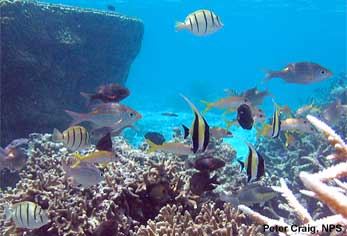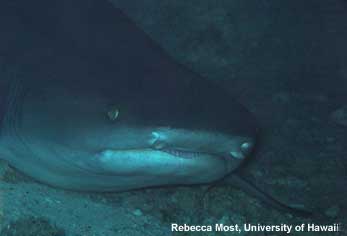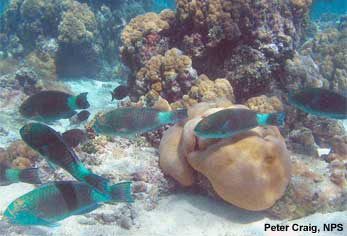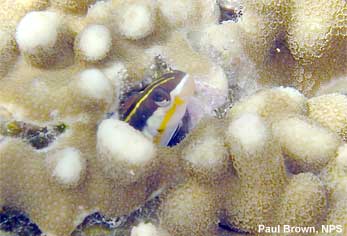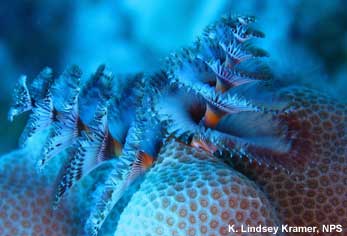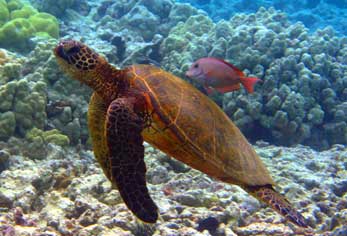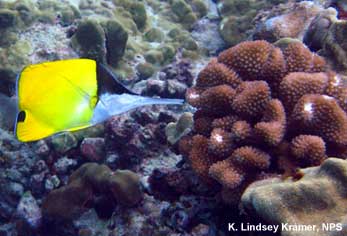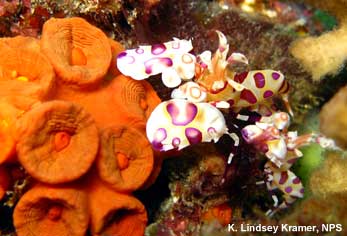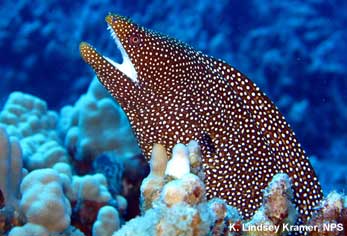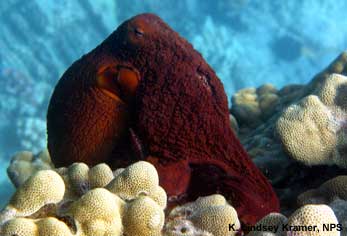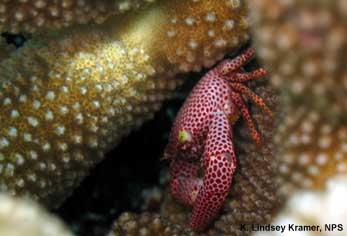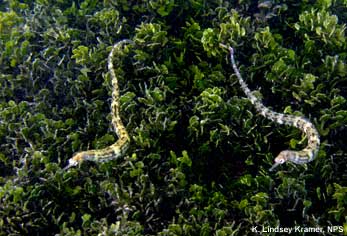What lives on a coral reef? |
In the Pacific islands, coral reefs have some of the highest biodiversity in the world. For example, Guam hosts over 3,500 species of plants and animals, including 200 different types of corals. That is an amazing number of organisms!
So many organisms like to live on coral reefs because they provide shelter and food. To escape predators, animals can hide within cracks and crevices in the reef created by corals. Nearly every living thing on a reef is food for another organism, and together they make up a complex food web.
Scientists are still discovering new species on coral reefs, which means that nobody knows exactly how many creatures live on coral reefs!
Hot spot: the Indo-Pacific is a center of amazing biodiversity
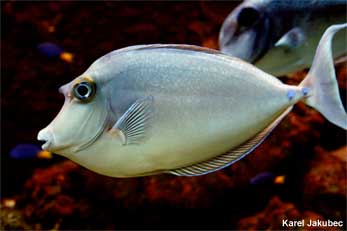 Southeast Asia is a hot spot of coral reef diversity and endemism (Conservation International 2007). Over time, ocean currents moved larvae from southeast Asia to the Pacific islands where they settled on coral reefs; thus, bringing more species to the region. War in the Pacific National Historical Park, being the U.S. national park closest to the center of this Indo-Pacific diversity hot spot, is home to a number of unique creatures such as the bluespine unicornfish (tatagaÊ»). As their name suggests, these fish have a horn on their heads and sharp blue spines at the base of their tails. They use these spines to defend themselves against predators. Coral reefs within this national park are home to an amazing variety of organisms—learn to identify them.
Southeast Asia is a hot spot of coral reef diversity and endemism (Conservation International 2007). Over time, ocean currents moved larvae from southeast Asia to the Pacific islands where they settled on coral reefs; thus, bringing more species to the region. War in the Pacific National Historical Park, being the U.S. national park closest to the center of this Indo-Pacific diversity hot spot, is home to a number of unique creatures such as the bluespine unicornfish (tatagaÊ»). As their name suggests, these fish have a horn on their heads and sharp blue spines at the base of their tails. They use these spines to defend themselves against predators. Coral reefs within this national park are home to an amazing variety of organisms—learn to identify them.
Hawaiian coral reefs provide habitat for organisms that live no where else in the world
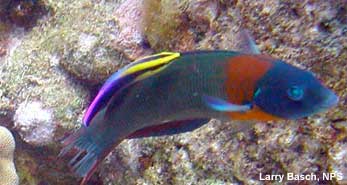 During the day, saddle wrasse (hÄ«nÄlea lauwili) hunt the reef for crustaceans, mollusks, and urchins to eat. At night, they hide in reef crevices to sleep. Saddle wrasse are endemic to Hawaii, meaning they are found nowhere else in the world. Far from other islands or continents, the Hawaiian Islands are home to numerous species that have evolved in isolation and become unique organisms. View photos of endemic Hawaiian species.
During the day, saddle wrasse (hÄ«nÄlea lauwili) hunt the reef for crustaceans, mollusks, and urchins to eat. At night, they hide in reef crevices to sleep. Saddle wrasse are endemic to Hawaii, meaning they are found nowhere else in the world. Far from other islands or continents, the Hawaiian Islands are home to numerous species that have evolved in isolation and become unique organisms. View photos of endemic Hawaiian species.
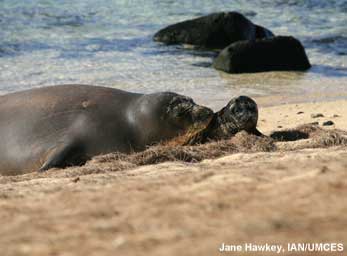 The Hawaiian monk seal is endemic to Hawaii. These mammals are often found at Kalaupapa National Historical Park and on other quiet beaches throughout the Hawaiian island chain, but they are not found anywhere else in the world. Monk seal populations are struggling to recover from the period in the early nineteenth century when large numbers of monk seals were hunted for their pelts. In 1976, the population was so small that the monk seal was declared an endangered species.
The Hawaiian monk seal is endemic to Hawaii. These mammals are often found at Kalaupapa National Historical Park and on other quiet beaches throughout the Hawaiian island chain, but they are not found anywhere else in the world. Monk seal populations are struggling to recover from the period in the early nineteenth century when large numbers of monk seals were hunted for their pelts. In 1976, the population was so small that the monk seal was declared an endangered species.
Today, Hawaiian monk seals are critically endangered. In recent years, the establishment of protected areas and work done by volunteers to protect seals when they haul out on crowded beaches have helped to increase the number of pups born on the main Hawaiian Islands. At Kalaupapa National Historical Park, Hawaiian monk seals use the remote beaches to pup their young.
Protecting coral reefs also helps to support the monk seal population. Monk seals hunt coral reef fish for food. Healthy reef fish populations means that there is more food available to them.
Faisua (giant clams) live long and grow large on coral reefs
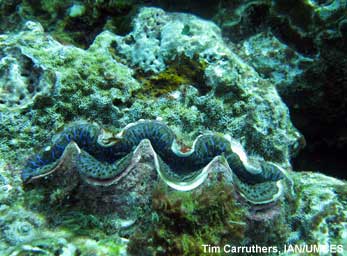 Many types of clams live on the coral reefs in the National Park of American Samoa, one of the most interesting is the faisua (giant clam). They have plant-like cells called zooxanthellae in their tissues (the same organisms that live in coral tissue). Faisua filter some of their food from the water, and get some food from their zooxanthellae. The giant clam can live for 100 years and weigh up to 200 kilograms. They are often found among coral heads or in sandy areas between the corals and can sometimes be seen in the National Park of American Samoa. See other organisms that live in the National Park of American Samoa through the photo gallery.
Many types of clams live on the coral reefs in the National Park of American Samoa, one of the most interesting is the faisua (giant clam). They have plant-like cells called zooxanthellae in their tissues (the same organisms that live in coral tissue). Faisua filter some of their food from the water, and get some food from their zooxanthellae. The giant clam can live for 100 years and weigh up to 200 kilograms. They are often found among coral heads or in sandy areas between the corals and can sometimes be seen in the National Park of American Samoa. See other organisms that live in the National Park of American Samoa through the photo gallery.
Clownfish and Sea anemones: A perfect partnership
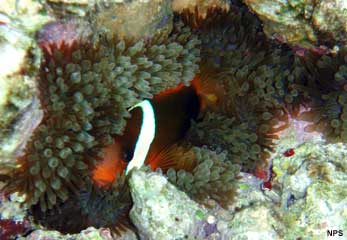 Clownfish and anemones have a special partnership, or symbiotic relationship, where each organism receives benefits just by living together. Sea anemones are not mobile, so they wait for their prey to swim by. Then, they capture small shrimp and fish with the poisonous barb in their tentacles. Their poison is harmful or deadly to almost all fish and shrimp. This poison protects them from many predators.
Clownfish and anemones have a special partnership, or symbiotic relationship, where each organism receives benefits just by living together. Sea anemones are not mobile, so they wait for their prey to swim by. Then, they capture small shrimp and fish with the poisonous barb in their tentacles. Their poison is harmful or deadly to almost all fish and shrimp. This poison protects them from many predators.
However, clownfish are immune to the sea anemone's poison. Thus, they are able to live among the tentacles safe from other fish. Clownfish are not interested in eating the sea anemone. So, they pose no threat. In fact, clownfish benefit the sea anemone by eating small invertebrates that would live on the anemone and potentially do it harm.
In this partnership, the sea anemone provides shelter for the clownfish, and the clownfish protects the sea anemone from pests.
| The Samoan legend of the atule run in Fagasa Bay shows the respect that Samoans have for those who came before and for the diverse resources of the ocean. Today, the stones that hold the memories of Liavaʻa, the man responsible for the atule run, and his daughter are cared for and honored during the atule harvest (Craig 2009). |

